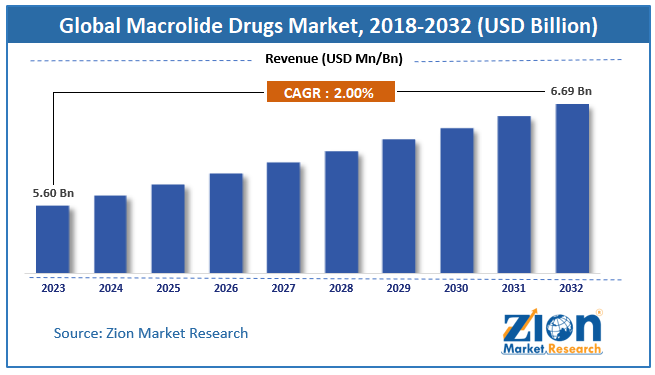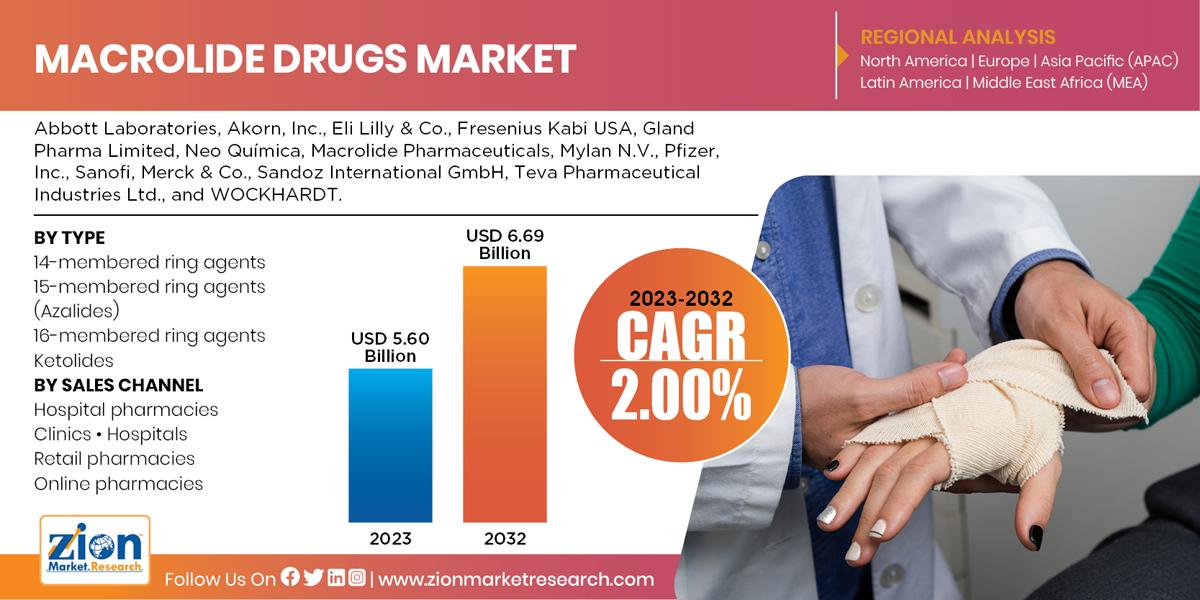Macrolide Drugs Market Size, Share, Trends, Growth and Forecast 2032

Macrolide Drugs Market by Drug Type (14-membered ring agents, 14-membered ring agents, 15-membered ring agents (Azalides), 16-membered ring agents, and Ketolides), By Distribution Channels (Hospital pharmacies, Clinics, Hospitals, Retail pharmacies, and Online pharmacies): Global Industry Perspective, Comprehensive Analysis and Forecast, 2024 - 2032
| Market Size in 2023 | Market Forecast in 2032 | CAGR (in %) | Base Year |
|---|---|---|---|
| USD 5.60 Billion | USD 6.69 Billion | 2.00% | 2023 |
Macrolide Drugs Market: Industry Perspective
The global Macrolide Drugs Market size was worth around USD 5.60 Billion in 2023 and is predicted to grow to around USD 6.69 Billion by 2032 with a compound annual growth rate (CAGR) of roughly 2.00% between 2024 and 2032. The Macrolide Drugs Market size is expected to develop revenue and exponential market growth at a remarkable CAGR during the forecast period from 2024–2032.
Global Macrolide Drugs Market: Overview
Macrolides are a class of antibacterial drugs that contain large macrocyclic lactone ring. One or more deoxy-sugars, usually desosamine and cladinose are attached to the macrocyclic lactone ring. The macrocyclic lactone ring generally is 14, 15, or 16 membered. Macrolides antibiotic is derived from Saccharopolyspora erythracea. Macrolides inhibit the protein synthesis in bacteria. The inhibition of protein synthesis is carried out by binding to the 50s ribosome. Macrolides are more effective against the gram-positive bacteria as well as the intracellular pathogens like Chlamydia, Mycoplasma, and Legionella. Macrolides primarily act as bacteriostatic agents opposite to several strains of Moxicella, Staphylococci Streptococci, Corynebacteria, Clostridia, Listeria, Neisseria meningitides, and Haemophilus sp.
Primary bacterial resistance to macrolides occurs due to the post-translational methylation of 23s bacterial rRNA. Because of mutation, the bacterial resistance is either plasmid-mediated or chromosomal. This results in the cross-resistance of macrolides, streptogramins, and lincosamides. Other two rarely seen acquired resistances are the production of drug-inactivating enzymes, as well as the production of active ATP-dependent efflux proteins which transport the drug outside of the cell.
The growth of the market can be attributed to the increasing demand for Macrolide Drugs owning to the Hospitals, Clinics, Hospitalshospital Pharmacies, Retail Pharmacies, Online Pharmacies Applications across the global level. The report provides insights regarding the lucrative opportunities in the Macrolide Drugs Market at the country level. The report also includes a precise cost, segments, trends, region, and commercial development of the major key players globally for the projected period.
The Macrolide Drugs Market report represents gathered information about a market within an industry or various industries. The Macrolide Drugs Market report includes analysis in terms of both quantitative and qualitative data with a forecast period of the report extending from 2024 to 2032. The report is prepared to take into consideration various factors such as Product pricing, Product or services penetration at both country and regional levels, Country GDP, market dynamics of parent market & child markets, End application industries, major players, consumer buying behavior, economic, political, social scenarios of countries, many others. The report is divided into various segments to offer a detailed analysis of the market from every possible aspect of the market.
The report covers forecast and analysis for the macrolide drugs market on a global and regional level. The study provides historical data from 2017 along with a forecast from 2023 to 2032 based on revenue (USD Billion). The study includes drivers and restraints for the macrolide drugs market along with the impact they have on the demand over the forecast period. Additionally, the report includes the study of opportunities available in the macrolide drugs market on a global level.
Global Macrolide Drugs Market: Growth Factors
Macrolide drugs market is expected to have a moderate growth during the forecast period attributing to the increasing prevalence of infectious diseases, in turn increasing the demand for drugs against the infections. Furthermore, a rising elderly population, an alarming rate of increasing number of multi-strain resistant bacterial strains as well as better benefits over the conventional antibiotics are driving factors for the macrolide drugs market. Macrolide drug is good for oral absorption; it is easy for absorption in tissues and also has an easier dosage of once or twice a day. Macrolide drug has very low incidences of side-effects. A study stated that macrolide may increase the risk of a sudden cardiac arrest, ventricular tachyarrhythmias, and cardiovascular deaths, also GI disturbances and inhibition of hepatic metabolism may hinder the growth of macrolide drugs market.
In order to give the users of this report a comprehensive view of the macrolide drugs market, we have included competitive landscape and analysis of Porter’s Five Forces model for the market. The study encompasses a market attractiveness analysis, wherein types, sales channel, and regional segments are benchmarked based on their market size, growth rate, and general attractiveness.
The report provides company market share analysis in order to give a broader overview of the key players in the market. In addition, the report also covers key strategic developments of the market including acquisitions & mergers, new type launch, agreements, partnerships, collaborations & joint ventures, research & development, regional expansion of major participants involved in the market on the global and regional basis.
Global Macrolide Drugs Market: Segmentation
The study provides a decisive view of the macrolide drugs market by segmenting the market based on types, sales channel, and regions. All the segments have been analyzed based on present and future trends and the market is estimated from 2018 to 2024.
Based on type, macrolide drugs market has been segmented into 14-membered ring agents, 14-membered ring agents, 15-membered ring agents (Azalides), 16-membered ring agents, and Ketolides.
Based on the sales channel, the macrolide drugs market has been segmented into hospital pharmacies, clinics, hospitals, retail pharmacies, and online pharmacies.
Based on region, macrolide drugs market is further segmented into North America, Europe, Asia Pacific, Latin America, and the Middle East & Africa.
Macrolide Drugs Market: Report Scope
| Report Attributes | Report Details |
|---|---|
| Report Name | Macrolide Drugs Market Size Report |
| Market Size in 2023 | USD 5.60 Billion |
| Market Forecast in 2032 | USD 6.69 Billion |
| Growth Rate | CAGR of 2.00% |
| Number of Pages | 188 |
| Forecast Units | Value (USD Billion), and Volume (Units) |
| Key Companies Covered | Abbott Laboratories, Akorn, Inc., Eli Lilly & Co., Fresenius Kabi USA, Gland Pharma Limited, Neo Química, Macrolide Pharmaceuticals, Mylan N.V., Pfizer, Inc., Sanofi, Merck & Co., Sandoz International GmbH, Teva Pharmaceutical Industries Ltd., and WOCKHARDT. |
| Segments Covered | By Drug Type, By Distribution Channels, and By region |
| Base Year | 2023 |
| Historical Year | 2018 to 2022 |
| Forecast Year | 2024 - 2032 |
| Customization Scope | Avail customized purchase options to meet your exact research needs. Request For Customization |
Macrolide Drugs Market: Regional Analysis
The regional segmentation includes the current and forecast demand for North America, Europe, Asia Pacific, Latin America, and the Middle East & Africa with its further bifurcation into major countries including the U.S. Germany, France, UK, China, Japan, India, and Brazil. This segmentation includes demand for macrolide drugs market based on individual segment and sales channel in all the regions and countries.
North America is anticipated to remain the principal region over the forecast period. Rising healthcare understanding and awareness about the drugs against the infections is expected to boost the market in this region. Europe was the second largest market followed by Asia Pacific. Asia Pacific is probably expected to show the highest growth rate during the forecast period while Latin America market is projected to grow at a moderate rate during the forecast period. The Middle East and Africa region is also expected to show a noticeable growth in the years to come with increasing awareness.
The key players in the global Macrolide Drugs Market are -
The report also includes detailed profiles of end players such as-
- Abbott Laboratories
- Akorn
- Eli Lilly & Co.
- Fresenius Kabi USA
- Gland Pharma Limited
- Neo Química
- Macrolide Pharmaceuticals
- Mylan N.V.
- Pfizer
- Sanofi
- Merck & Co.
- Sandoz International GmbH
- Teva Pharmaceutical Industries Ltd.
- WOCKHARDT.
This report segments the global macrolide drugs market as follows:
Global Macrolide Drugs Market: By Type
- 14-membered ring agents
- 15-membered ring agents (Azalides)
- 16-membered ring agents
- Ketolides
Global Macrolide Drugs Market: By Sales Channel
- Hospital pharmacies
- Clinics
- Hospitals
- Retail pharmacies
- Online pharmacies
Global Macrolide Drugs market: By Region
- North America
- The U.S.
- Europe
- UK
- France
- Germany
- Asia Pacific
- China
- Japan
- India
- Latin America
- Brazil
- Middle East and Africa
Table Of Content
Methodology
FrequentlyAsked Questions
The global Macrolide Drugs Market size was worth around USD 5.60 Billion in 2023 and is predicted to grow to around USD 6.69 Billion by 2032
compound annual growth rate (CAGR) of roughly 2.00% between 2024 and 2032.
The largest share of the Macrolide Drugs Market is held by Asia Pacific. Developing countries of Asia Pacific such as China, Japan, and India will be dominating the market scenario mainly due to the rising constructional activities. The growth of Asia-Pacific region is expected to be followed by the Middle East and North America. Also, significant growth is expected from Western Europe owing to the developments taking place in this region especially in countries such as Italy, Germany, the U.K, France, and Spain. However, growth in Africa, Latin America, and Eastern Europe is anticipated to be moderate over the forecast period.
Abbott Laboratories, Akorn, Inc., Eli Lilly & Co., Fresenius Kabi USA, Gland Pharma Limited, Neo Química, Macrolide Pharmaceuticals, Mylan N.V., Pfizer, Inc., Sanofi, Merck & Co., Sandoz International GmbH, Teva Pharmaceutical Industries Ltd., and WOCKHARDT.
RelatedNews
HappyClients
Zion Market Research
Tel: +1 (302) 444-0166
USA/Canada Toll Free No.+1 (855) 465-4651
3rd Floor,
Mrunal Paradise, Opp Maharaja Hotel,
Pimple Gurav, Pune 411061,
Maharashtra, India
Phone No +91 7768 006 007, +91 7768 006 008
US OFFICE NO +1 (302) 444-0166
US/CAN TOLL FREE +1 (855) 465-4651
Email: sales@zionmarketresearch.com
We have secured system to process your transaction.
Our support available to help you 24 hours a day, five days a week.
Monday - Friday: 9AM - 6PM
Saturday - Sunday: Closed







